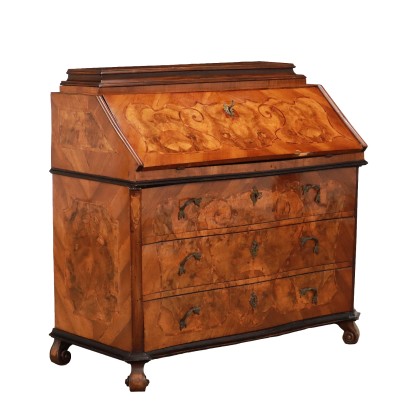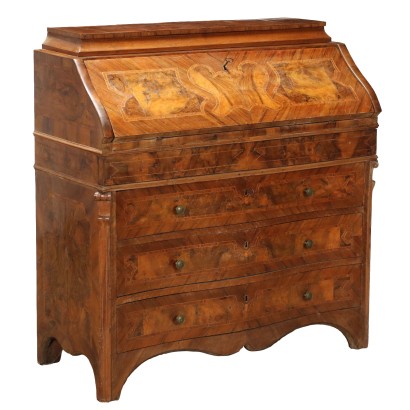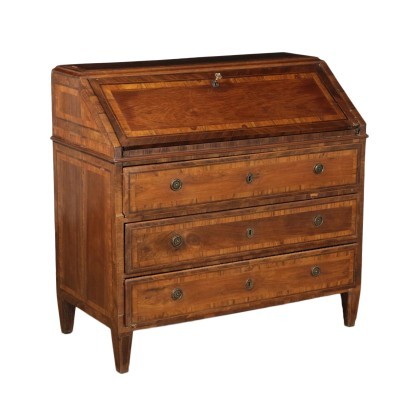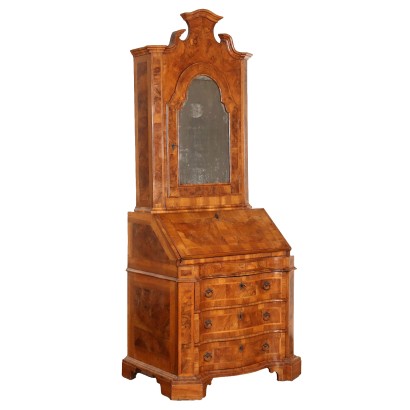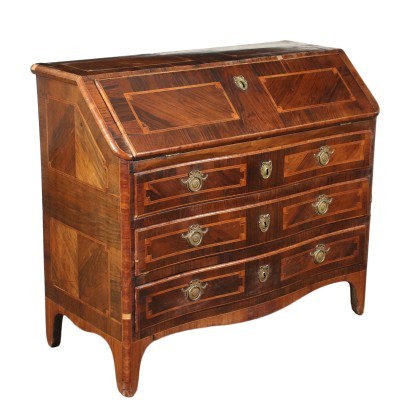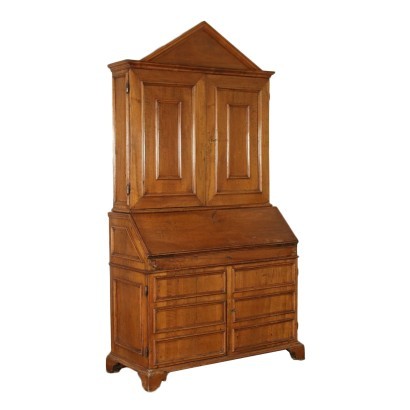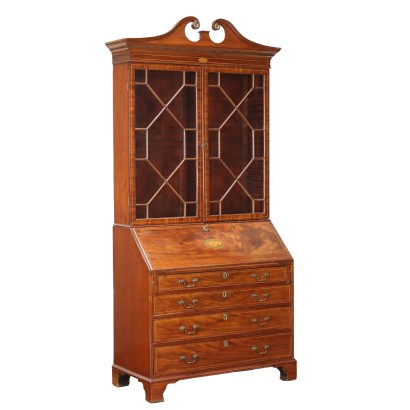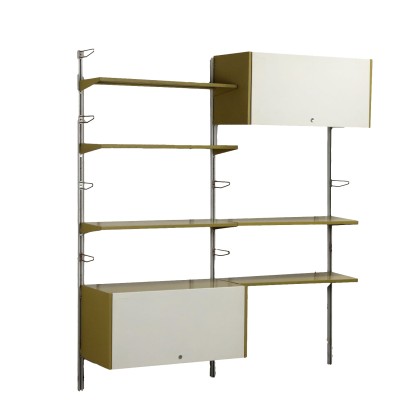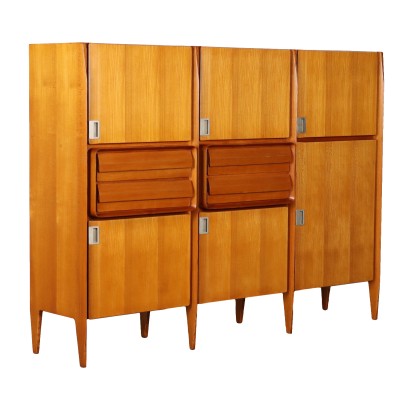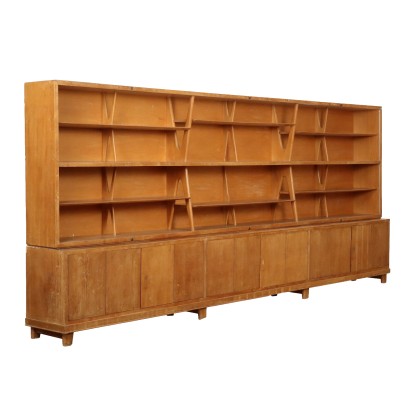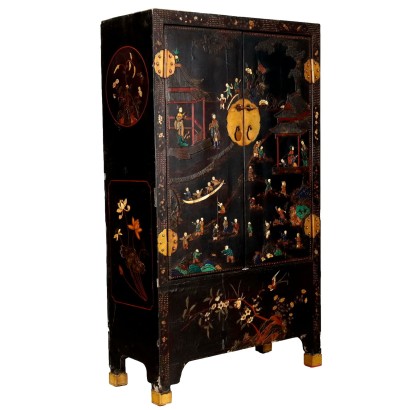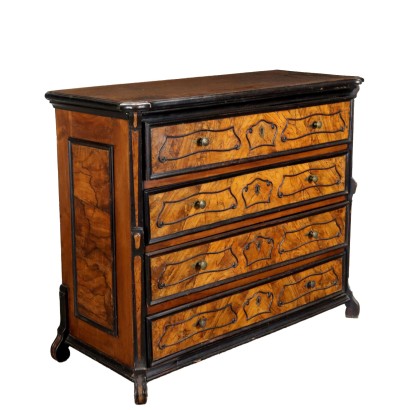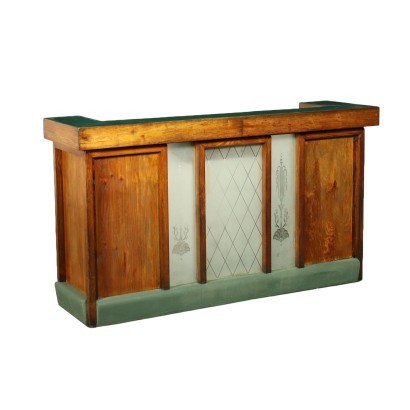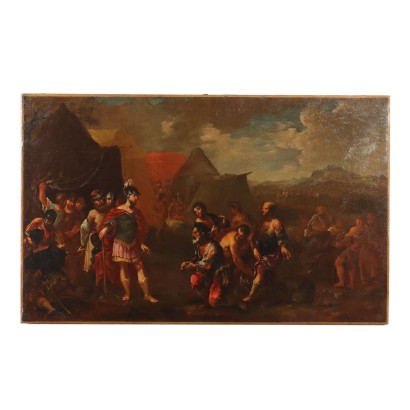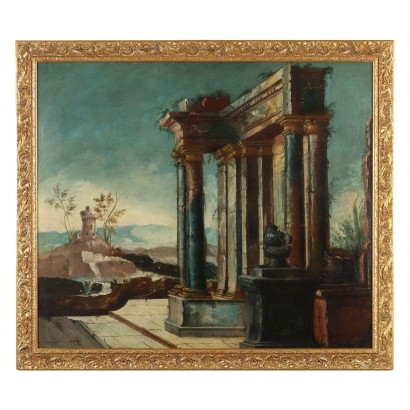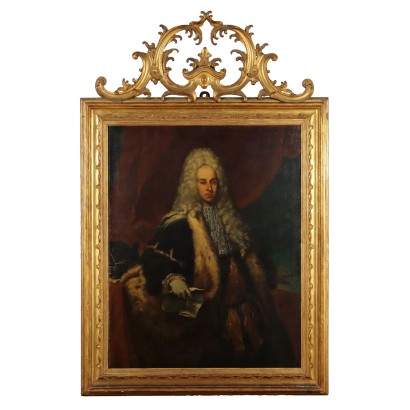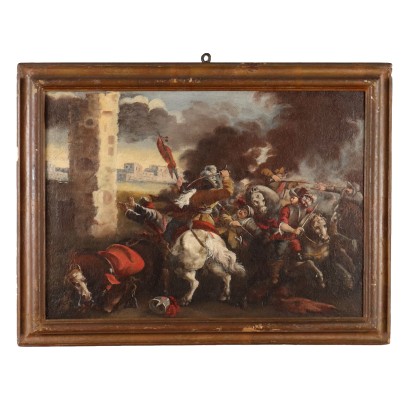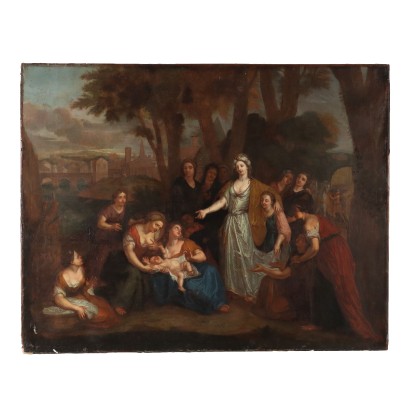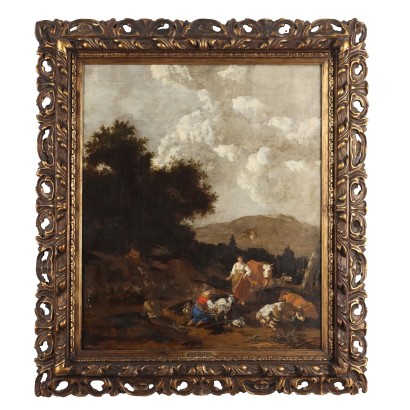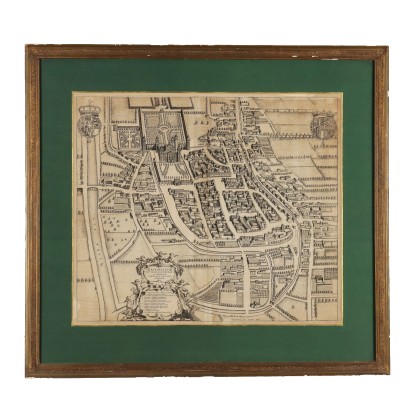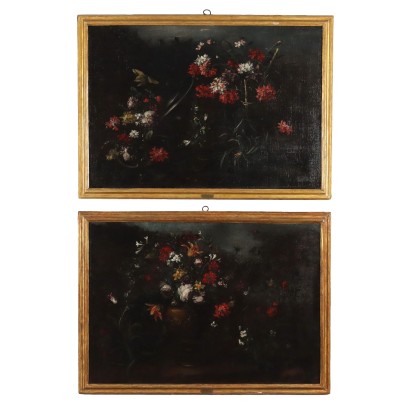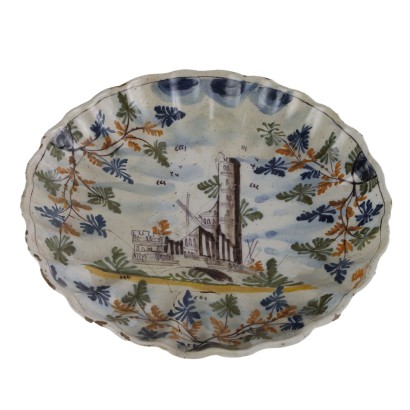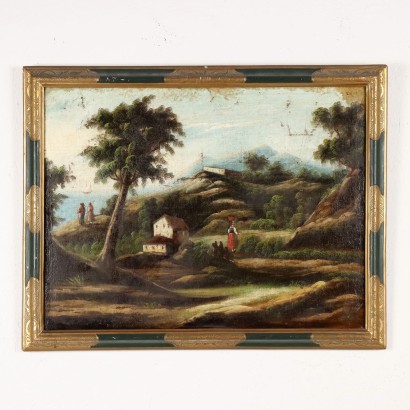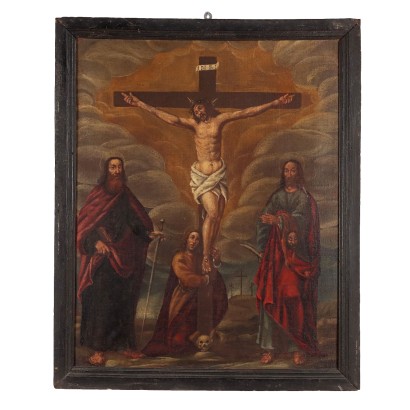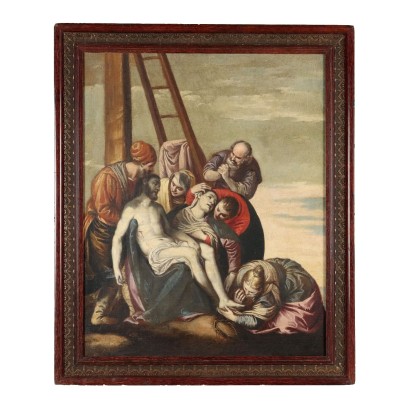Ancient Baroque Flap Cabinet Walnut Italy XVIII Century - Lombardy Mid-eighteenth century
Features
Lombardy Mid-eighteenth century
Style: Barocchetto (1720-1770)
Age: 18th Century / 1701 - 1800
Origin: Lombardia, Italy
Main essence: Silver Fir , Maple , Cypress , Walnut
Material: Walnut Slab , Walnut Burl Slab , Ebony Wood
Description
Walnut veneered baroque flap, Lombardy mid-18th century. Upstand with pair of side drawers, front with flap door concealing cabinet, 3 drawers and curly feet. Tripartite by 3 ebonized frames, the piece of furniture is decorated with walnut root reserves, maple threads and cypress borders, the latter arranged to create a large heart-shaped cartouche on the front. Interior in fir. Cabinet restorations and replacements; non-coeval handles.
Product Condition:
Product that due to age and wear requires restoration and re-polishing. We try to present the real state of the furniture as fully as possible with photos. If some details are not clear from the photos, what is reported in the description will prevail.
Dimensions (cm):
Height: 115,5
Width: 130
Depth: 57
Additional Information
Style: Barocchetto (1720-1770)
With this term we designate, for what specifically relates to furniture, a part of the production carried out in Italy in the period of time between the Rococo era and the first phase of neoclassicism.It is characterized by the formal and decorative structure still rigidly adhering to the dictates dear to the Baroque period (hence the term baroque) and to the Louis XIV fashions and yet the new times are captured in the adoption of smaller volumes, more decorative modules. elegant, often directly inspired by French fashion, but always executed with rigorous principles of ornamental symmetry.
The tendency to assimilate formal and volumetric novelties but not to incorporate their ornamental elaboration finds natural explanation in Italy in the fact that in this century the great aristocracy experienced an unstoppable political and economic decline.
If in the previous century there was a great profusion of furnishings destined to adorn newly built homes, to proudly show the power of the client family, in the eighteenth century they rather take care to update the building with only the furniture strictly necessary for the new needs imposed by fashion or functional needs.
The old scenographic apparatus is maintained and the new must not contrast too much.
Find out more about the Barocchetto with our insights:
Classic Monday: discovering Barocchetto
Classic Monday: between Baroque and Barocchetto
Classic Monday elegant and unusual with two Barocchetto balustrades
FineArt: Pair of Barocchetto chairs, Venice
Emilian canterano first quarter XVIII century, first Barocchetto
Ribalta a urn, Milan mid-18th
Age: 18th Century / 1701 - 1800
18th Century / 1701 - 1800Main essence:
Silver Fir
Soft coniferous wood, used for rustic furniture or to build the chest, that is the structure, of furniture then veneered in more precious woods. It has been used since ancient times, its most valuable use is, in the Spruce variant, in the inlays of French antique furniture of the '700 . The spruce, more typical of northern Europe, in Italy grows mainly in the Eastern Alps at altitudes above 1300 m. The noblest use of this essence was in the construction of violins, guitars and cellos: Stradivari himself produced his famous violins with this wood.Maple
Hard, light wood used for inlays. It grows mainly in Austria, but it is widespread throughout the northern hemisphere, from Japan to North America, passing through China and Europe. It is one of the lightest woods ever, tending to white, it is similar to lime or birch wood. The briar is used in the production of ancient secretaires .Cypress
It is a hard wood, originating from one of the most long-lived plants, it exists in different species. The French variant is light red with darker veins, the cabinetmakers used it more in the inlays. The Asian variant, with shades more greenish, was used in England for the supporting structures of the furniture. In both the United States and Europe it was used for the production of rustic and popular furniture.Walnut
Walnut wood comes from the plant whose botanical name is juglans regia , probably originally from the East but very common in Europe. Light or dark brown in color, it is a hard wood with a beautiful grain, widely used in antique furniture. It was the main essence in Italy throughout the Renaissance and later had a good diffusion in Europe, especially in England, until the advent of mahogany. It was used for solid wood furniture and sometimes carvings and inlays, its only big limitation is that it suffers a lot from woodworm. In France it was widely used more than anything else in the provinces. In the second half of the eighteenth century its use decreased significantly because mahogany and other exotic woods were preferred.Material:
Walnut Slab
Walnut Burl Slab
Ebony Wood
Other customers have searched:
Ribalte, trumeau, bureau, ribalta con alzata, cassettiera con ribalta, scrittoio, secretaire, stipo..
Dai un'occhiata anche ai nostri approfondimenti sul blog e alle presentazioni dei prodotti FineArt:
Leggi di più
Un cassettone a ribalta, espressione del gusto veronese di pieno Settecento
Secrétaire, il mobile con i nascondigli
Scrittoio a dorso d'asino, Piacenza, metà XVIII secolo
Cassettone a ribalta, Roma, secondo quarto XVIII secolo
Ribalta a urna, Milano metà XVIII secolo
Secrétaire, Bottega Francesco Maggiolini, primo quarto XIX secolo
Secrétaire, “Bottega dei fondi verdi”, inizi XIX secolo
Trumeau con anta a ribalta, Queen Anne, Inghilterra 1705 ca.
Sull'antiquariato in generale dai un'occhiata anche a:
Classic Monday: da un pezzo dei nostri magazzini alla storia dell'antiquariato
L'antiquariato dalla A alla Z: il Dizionario dell'Antiquariato
Il dizionario dell'antiquariato - Lastronatura
Il dizionario dell'antiquariato - Mascherone
Il dizionario dell'antiquariato - Natura morta
Il dizionario dell'antiquariato - Opificio
Il dizionario dell'antiquariato - Pastiglia
Il dizionario dell'antiquariato - Savonarola
Il dizionario dell'antiquariato - Rosone
Intaglio barocco con motivo a ricciolo
Leggi di più
Un cassettone a ribalta, espressione del gusto veronese di pieno SettecentoSecrétaire, il mobile con i nascondigli
Scrittoio a dorso d'asino, Piacenza, metà XVIII secolo
Cassettone a ribalta, Roma, secondo quarto XVIII secolo
Ribalta a urna, Milano metà XVIII secolo
Secrétaire, Bottega Francesco Maggiolini, primo quarto XIX secolo
Secrétaire, “Bottega dei fondi verdi”, inizi XIX secolo
Trumeau con anta a ribalta, Queen Anne, Inghilterra 1705 ca.
Sull'antiquariato in generale dai un'occhiata anche a:
Classic Monday: da un pezzo dei nostri magazzini alla storia dell'antiquariato
L'antiquariato dalla A alla Z: il Dizionario dell'Antiquariato
Il dizionario dell'antiquariato - Lastronatura
Il dizionario dell'antiquariato - Mascherone
Il dizionario dell'antiquariato - Natura morta
Il dizionario dell'antiquariato - Opificio
Il dizionario dell'antiquariato - Pastiglia
Il dizionario dell'antiquariato - Savonarola
Il dizionario dell'antiquariato - Rosone
Intaglio barocco con motivo a ricciolo
Product availability
The product can be seen at Cambiago
Immediate availability
Ready for delivery within 2 working days from ordering the product.



